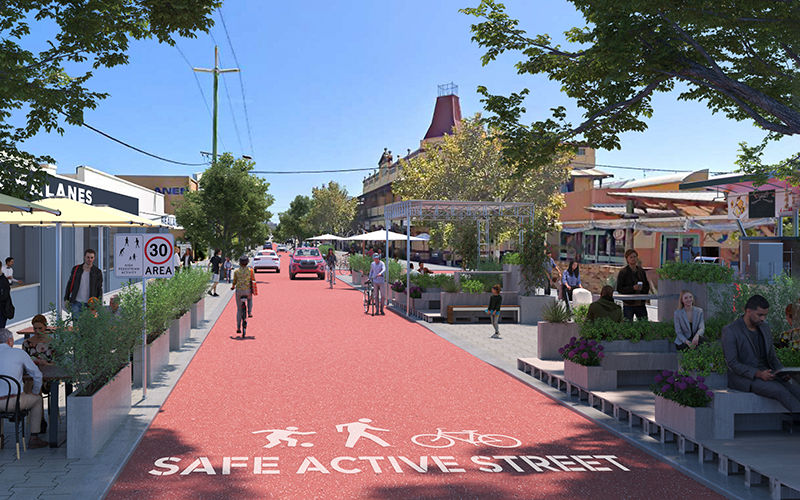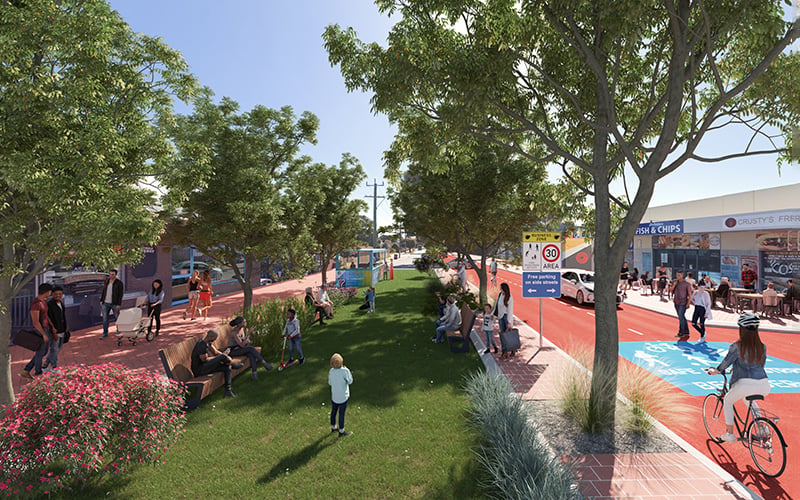
Pictured: After, Parklet and modifications, South Terrace, Fremantle, Perth
Researchers from The Kids Research Institute Australia, The University of Western Australia, Curtin University and The University of Southern Denmark have identified 10 Australian shopping strips where the removal of on-street parking would transform the area’s liveability.
In an article published by The Conversation, the researchers argue that creating pedestrian malls and parklets where people can move freely would help to tackle the rising cost of Australia’s inactivity crisis.
Researcher Dr Matthew McLaughlin from The Kids Research Institute Australia and the UWA said making shopping strips safer for pedestrians and more pleasant to access would be good for local businesses.
“Creating an inviting space for shoppers that feels safe and easy to access is crucial for shopping strip businesses, who are competing with large indoor shopping malls,” he said.
It’s already extremely rare to get a parking spot right outside the shop you want to visit on a shopping strip, so moving parking to a side street would not require a huge behaviour change for shoppers.
“It would also encourage those shoppers who are able to walk or cycle to the shops from home to do so.”
The shopping strips identified by researchers are: Chapel St, Windsor (VIC) Beaumont St, Newcastle (NSW) Darby St, Newcastle (NSW) Hall St, Bondi (NSW), Princess Highway, Woolongong (NSW) Belvidere St, Belmont (WA), Oxford St, Leederville (WA) South Terrace, Fremantle (WA) and Musk Avenue, Kelvin Grove (QLD).
The researchers found that on average, car parking (27%) and travel lanes (46%) took up almost three-quarters of the available street space, leaving little room for pedestrians and alfresco dining.
In the re-imagined street spaces, parking and travel lane space was reduced by around one-third (32%), allowing an increase in green space (18%), seating (17%) and footpaths (6%).
M McLaughlin said many cities and towns overseas are already moving towards reduced parking along their busy shopping strips.
“Tens of thousands of on-street car parks have been removed to make space for pedestrians, including in Auckland, Stockholm, Paris and Milan,” he said.
The changes would also have a big impact on local traffic congestion by reducing the ability to use the streets as rat-runs to avoid the main arterials. Providing more space for alfresco dining is also a huge draw-card, especially in the era of COVID-19.
Dr McLaughlin said creating an attractive shopping and dining destination would encourage more families to walk or ride to their local shopping strip.
“It would be a safer place for kids and families to spend time outside, and that’s great for their physical and mental health,” he said. “Inactivity costs the Australian economy $15.6 billion every year, through for example, the burden of obesity on the health system.
“Given more than half of the car journey made in an Australian city are under 5 kilometres, we really need to do more to encourage walkable cities and suburbs.”
Access the full list of re-imagined streetscapes with before and after images here.

Pictured: After, Belvidere Street, Belmont, Perth
